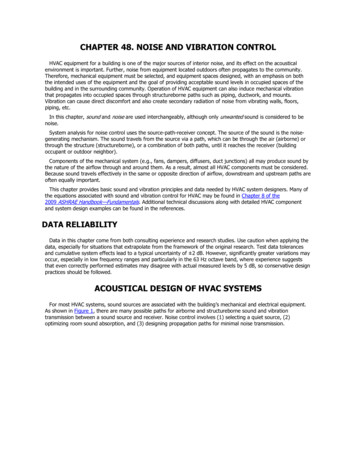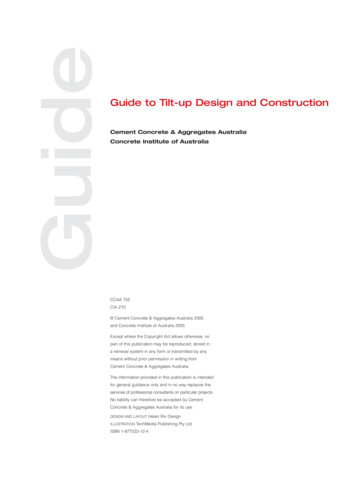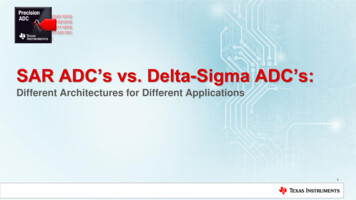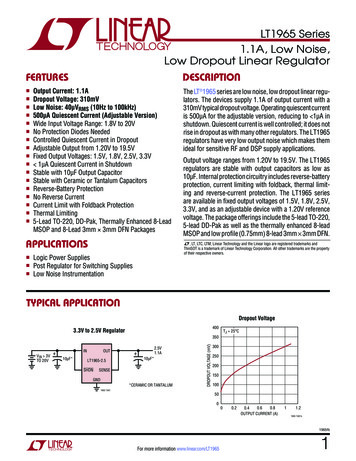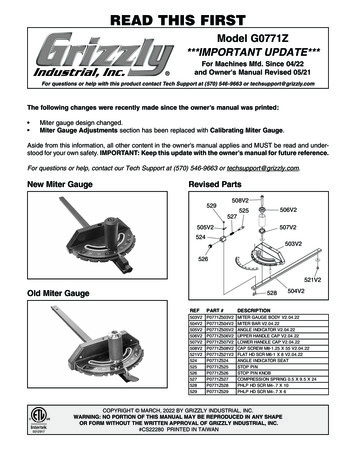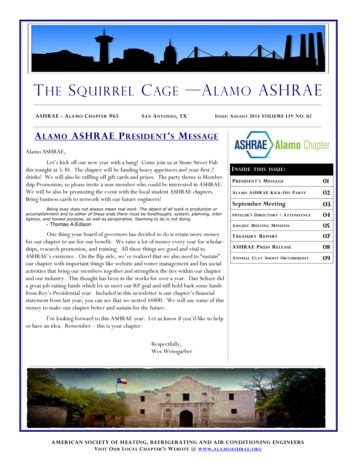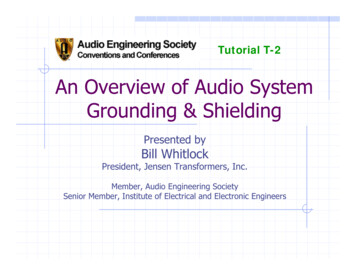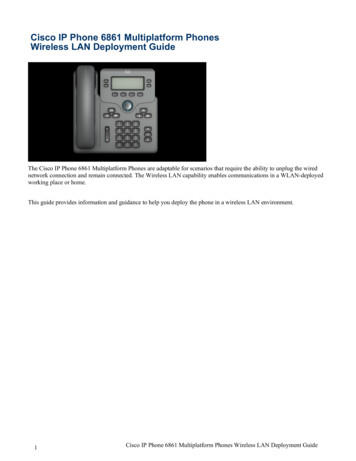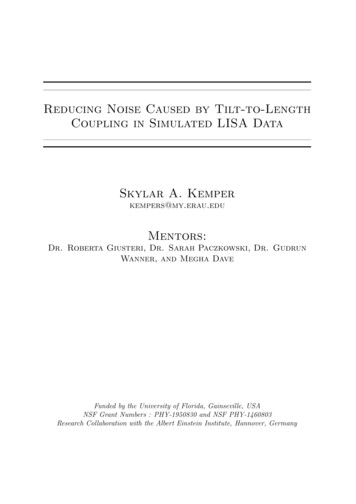
Transcription
Reducing Noise Caused by Tilt-to-LengthCoupling in Simulated LISA DataSkylar A. Kemperkempers@my.erau.eduMentors:Dr. Roberta Giusteri, Dr. Sarah Paczkowski, Dr. GudrunWanner, and Megha DaveFunded by the University of Florida, Gainseville, USANSF Grant Numbers : PHY-1950830 and NSF PHY-1460803Research Collaboration with the Albert Einstein Institute, Hannover, Germany
Contents1 Abstract22 Introduction23 Theory33.1Geometric TTL Estimations . . . . . . . . . . . . . . . . . . . . . . . . . . .53.2Tilt-to-Length Subtraction through Time Delay Interferometry . . . . . .94 Results104.1Geometric TTL Estimations . . . . . . . . . . . . . . . . . . . . . . . . . . .104.2Tilt-to-Length Subtraction through Time Delay Interferometry . . . . . .155 Conclusion215.1Geometric TTL Estimations . . . . . . . . . . . . . . . . . . . . . . . . . . .215.2Tilt-to-Length Subtraction through Time Delay Interferometry . . . . . .236 References231
1AbstractAngular instability in the LISA satellites leads to a unique noise known as Tilt-to-LengthCoupling (TTL). This paper explores two methods for reducing the noise created by TTL.The first half of the paper explores Geometric TTL estimations, because Geometric TTLis effected by the design of the test mass interferometers and long arm interferometers, thefirst goal was to identify where TTL impacts results significantly by creating estimationsfor beam waist changes and photodiode shifts. The second half of the paper exploresmethods for subtracting TTL noise from a simulated data set with Galactic ForegroundNoise injected into it. For Geometric TTL estimations, We were able to achieve TTLestimations below desired noise range (10 12 ) around an average 10 13 . In regards tothe TTL subtraction, we found that Foreground noise makes a difference in the TTLcoefficient results, and we achieved better estimations for TTL coefficients when adjustingthe frequency range from 1e-4 (Hz) to 2e-3 (Hz). However, we were unable to achieve arange capable of subtracting TTL enough to be useful.2IntroductionThe Laser Interferometer Space Antenna (LISA) is a project led by the European SpaceAgency (ESA) set to launch in the early 2030’s [4]. LISA is following the successful detection of gravitational waves using ground based interferometers. Gravitational waveshave allowed us to observe the universe at a deeper level, such as when the LIGO detectors’ were able to record gravitational waves caused by a pair of black holes mergingin 2015[3]. Additionally, LISA also follows several space interferometers, such as LISAPathfinder, which provided insight into how a space based interferometry system can2
function. Lisa Pathfinder utilized specialized inertial sensors, a drag-free control system, micro-propulsion, and a laser metrology system. Considering LISA Pathfinder usedmany of the same technologies intended for LISA, it allowed physicists to observe noiseand errors which LISA will encounter and figure out solutions before LISA launches [2].A space-based interferometer will provide a reduction in seismic and gravity gradientnoise that would have interfered with low frequency observations on earth. LISA consists of three identical spacecraft moving in orbit, behind the Earth. The duration ofthe project will span 4-years and LISA will be capable of detecting Black Hole binaries,Compact binaries, Extreme Mass Ratio Inspirals, and other bodies with gravitationalwaves between 0.1mHz and 100mHz [1].3TheoryLISA Pathfinder observed the impact of Tilt-To-Length (TTL) noise interfering with itsresults after it’s launch. The TTL presented itself as a bulge between the 200mHz - 20mHz frequency range. This is produced by the effects of cross coupling the jitters ofthe satellite into the longitudinal readout, see figure (1). TTL noise is specific to thecurrent design being used for space interferometry because of the test mass and long arminterferometers.The current LISA set-up includes three separate satellites with long arm interferometers exchanging beams of light between the free-falling test masses inside them. Thedistance between these satellites can be changed by gravitational waves. The test massinterferometers are used to measure the changes impacting the free-falling tests massesand the long arm interferometers between spacecraft. The satellites all have separate optical benches with the test mass interferometers to measure the distance changes for the3
test mass inside that specific spacecraft and the optical bench itself. Meanwhile, the longarm interferometers measure changes which occur between the satellites locally and remotely. This makes for 6 test masses, 2 for each satellite, 6 test mass interferometers, and3 long arm interferometers, all working in sync between spacecraft to detect gravitationalwaves based on changes in the interferometer’s light path. LISA Pathfinder was able todemonstrate this concept on a single satellite, with only the test mass interferometers,leading to the problem with TTL [5].Due to the impact of TTL on LISA Pathfinder’s results the data was less useful. Inorder to remove the TTL noise, the subtraction method was applied. This method isaccomplished by figuring out the coefficients for each of the jittering components andsubtracting it from the frequency. The equation used for subtraction is depicted belowand each component is the differential acceleration measurement for each jitter direction(1). gx talk C1 φ̄ [t] C2 η̄ [t] C3 ȳ [t] C4 z̄ [t] C5 ȳ[t] C6 z̄[t] δif o ẍ1 [t](1)Figure (1) shows the LISA Pathfinder results with the jitter as well as the resultswith the jitter subtracted via equation (1).4
Figure 1: TTL Noise observed by LISA pathfinder is depicted in figure (1). The redcurve includes noise caused by jitters in the satellite. The blue line shows the subtractionmethod being applied to the signal to reduce the geometric TTL. [6]3.1Geometric TTL EstimationsGeometric cross coupling is caused by lateral and angular jitters or movement in thespacecraft. Due to the free-falling masses moving with all degrees of freedom, the changesto the spacecraft cause lateral and angular movements in the test mass, which thenchanges the distance the beam of light travels after interacting with the test masses.Because LISA interferometer detections depend on changes to the length of light causedby gravitational waves, changing the path length through other sources disrupts resultscreating the noise. Therefore, TTL creates noise which can impact the results and confusethe actual signal [6].5
For the Geometric TTL estimations, several aspects of geometric set up were considered. The Longitudinal Pathlength Signal (LPS) is the total distance the light travelsthroughout the simulation. The Optical Pathlength Difference (OPD) however, onlyrefers to the change between the measurement beam (Mbeam) and the reference beam(Rbeam) caused by TTL. See equation (2).OP D M easurement Beam – Ref erence Beam(2)While the OPD and LPS refer to geometric components of the set-up, the nongeometric coefficient can be found by subtracting the LPS coefficient from the OPDcoefficient.N on Geometric Component LP S Coef f icient – OP D Coef f icient(3)The simulation used to estimate TTL was created using C and the IfoCAD software at the Albert Einstein Institute, it was designed as depicted in figure (2). Thesimulation includes a Quadrant Photodiode (QPD) to transition the light into voltageand read the signal for the amount of light (photons) present. There are two beamsdepicted in the set up, both beams are astigmatic gaussian beams which means they areelliptical instead of strictly circular. The measurement beam is the actual beam beingobserved, and it is a part of the LPS. The reference beam shows where the measurement beam is theoretically supposed to be, and it shows where we want the beam to belocated.The secondary factors to consider, which are depicted in figure (2), are the geometricchanges simulated in the code which are observed throughout this project. Some of the6
those observed changes include lateral and longitudinal shifts which are depicted by thegreen arrows. Outside of lateral and longitudinal shifts, we also observed changes to themeasurement beams waist size and waist location, see figure (3).Figure 2: Diagram depicting the IfoCAD simulation in terms of what is theoreticallyhappening if the simulation were real light beams and equipment.7
Figure 3: Diagram depicting the changes impacting the measurement beam waist forthe IfoCAD simulation. Where the beam waist itself is defined by W0 , the changes tothe beam waist size are represented by W1 showing the squeezing and expanding of thebeam waist. W2 shows the beam waist location changes, where the beam waist W0 ismoved along the axis, changing the measurement beam divergence and shape.The equation used to determine the TTL estimations is derived through creatinggraphs of the results. To begin, the first graph depicts the relationship between LPSoffset (m) and the angle of the offset (rad). The data is fit to a second order polynomialas depicted by equation (4). Or a first order polynomial as depicted in equation (5).LP S Cm 2φrad2(4)mφrad(5)LP S CmNext, a second graph is created using the Coefficient (C) ( rad2 ) values from the first8
graph and equations (4) - (5). This graph depicts the Longitudinal or Lateral Offset ofmQPD (m) from the Coefficient value ( rad2 ). The second graph is used to find the valuem2for the final Coefficient (Coeff.) ( radm ) using equation (6).Coef f C(1, 1) dlong C(1, 2)(6)rad) represent the displacement longitudinal or lateral from the QPD.Where dlong ( rtHzUsing the values from equation (6), equation (7) can be created to find a TTL estimation.T T L Estimation 2 Coef f φ φof f(7)Where φof f is the offset of the angle (φ) (rad) given in equation (8) for the data beinganalyzed.φof f 50 10 6(8)The final equation used to determine the TTL estimation comes from combiningequations (5) and (6) to create equation (9). The intercept comes from the intercept ofeach line from the secondary graphs (2).T T LEstimation 2 φof f φ Coef f dlong Intercept3.2(9)Tilt-to-Length Subtraction through Time Delay InterferometryThere are two central types of noises which impact LISA, Instrumental noise and GalacticForeground Noise. Galactic Foreground Noise is composed of all the signals LISA will9
measure from the galaxy. A majority of the noise comes from double white dwarf binarieswhich is why a lot of the time other sources are ignored in favor of just the white dwarfbinaries. After a source has been identified, however, it can be subtracted from theoverall Galactic Foreground Noise which allows us to whittle it down to just what canbe resolved. The residual is what composes the the background noise.For this project the Galactic Foreground noise is simulated using a LISAsolve softwarein which every binary is modeled in the frequency domain and only double binary whitedwarfs are simulated. Unresolved Galactic Foreground Noise comes from subtractingresolved binary sources from the simulated population of binaries, creating the noiseused in this project.44.1ResultsGeometric TTL EstimationsThrough running the simulation described under Geometric TTL estimation’s theorysection, without changing any variables, we were able to develop a graph for the angleand the LPS with a rotation at the photodiode center. However, in order to observe theimpacts of longitudinal and lateral QPD shifts we added those shifts on to two separategraphs to observe the changes, see figures (4) and (5) respectively.10
Figure 4: Graph depicting the angle (φ) vs the LPS(m) with longitudinal displacementin steps of 10µm from 0 to 100µm.The impacts show a linear increase between each of the steps for both lateral andlongitudinal displacement. Through using the coefficients for the slopes of each line wecreated another graph with the coefficients and the longitudinal shifts. This models thelinear relationship between the steps. We repeated the process for the 4 beam waistlocation shifts, -1.5m, -.75m, .75m, and 1.5m. These shifts are chosen arbitrarily andare just to see a range of what is there. The process is repeated in the same manner,including the longitudinal and lateral shifts, but the measurement beam waist is shiftedto -1.5m, -.75m, .75m, or 1.5m, respectively. For longitudinal shifts we get figure (5) andlateral shifts figure (6).11
Figure 5: Graph depicting the QPD longitudinal offset (m) and the coefficients (C)(found using equation (4)) from the previous graphs for all 5 measurement beam waistlocation changes.12
Figure 6: Graph depicting the lateral displacement (m) and the coefficients (C) (foundusing equation (5)) from the previous graphs for all 5 measurement beam waist locationchanges.While the longitudinal displacements shown in figure (5) are impacted by the measurement beam waist location changes, the lateral displacement in figure (6) is not. Thiswas also done for the OPD, but there were no significant changes made from the initial.Because there were no changes, the OPD data sets were not considered further. Thefit line equations created from the secondary grouping of graphs with longitudinal ormlateral offset of QPD (m) against the Coefficient values ( rad2 ) were used to find TTLestimations using equation (9).The process was repeated for longitudinal and lateral data, however, instead of thebeam waist location being shifted it was resized by factors of 5%, 10%, 0%, 5%, 10%which equate to .0448m, .0224m, 0, -0.224m, .0448m. When applied to the normal beam13
waist of 0.448m, the new beam waists are .4928, .4704m, .448m, .4256m, and .4032m.The first set of graphs is not depicted for the beam waist being resized. The secondarygroup of graphs for the coefficient and the LPS QPD shifts are depicted by figures (7)and (8) respectively.Figure 7: Graph depicting the longitudinal displacement (m) and the coefficients (C)(found using equation (4)) from the previous graphs for all 5 measurement beam waistresized.14
Figure 8: Graph depicting the lateral displacement (m) and the coefficients (C) (foundusing equation (5)) from the previous graphs for all 5 measurement beam waist resized.The results for TTL estimations can be found in the conclusions section.4.2Tilt-to-Length Subtraction through Time Delay InterferometryTo begin the TTL subtraction project, the code had already been written to produce a1graph of the Frequency (Hz) and the Amplitude Spectral Density (mHz 2 ). Depicted forthe Unlocked LISA configuration on Day 1 of recording the Foreground seen in figure (9).Where the red line represents the analytic TDI (Time Delay Interferometry), the greenline shows the TDI X without Foreground noise, the black line shows the TDI X withForeground noise, the cyan line is an artificial TTL contribution (2.3 (mm/rad)) pro15
grammed into the code which we are trying to estimate, and the magenta line representsTDI X with Foreground noise and TTL noise subtracted.1Figure 9: Graph of Frequency (Hz) vs. the Amplitude Spectral Density (mHz 2 ) forDay 1 of the Unlocked LISA configuration.A significant note in regards to figure (9) is that most of the variance occurs between1e-4 (Hz) and 2e-3 (Hz). Because of this we later on extended the frequency from the 1e-4(Hz) to 2e-3 (Hz). We created graphs of the Frequency (Hz) vs. the Amplitude Spectral1Density (mHz 2 ) for Days 1 - 5 of the Foreground data and LISA Configurations from16
Unlocked, N1a, N2a, N1b, N2b, N1c, and N2c. In order to observe the changes causedby the Configurations, figure (10) was created. Figure (10) shows the Configurationsagainst the Deviations for every variable of the TTL contributions which we are tryingto estimate.Figure 10: Graph of the Configurations vs the Deviations from each other for Day 1 ofthe Foreground data set.We then repeated the same process for the days 1-5 showing Configuration Unlocked,represented in figure (11).17
Figure 11: Graph of the Days vs the Deviations from each other for ConfigurationUnlocked of the Foreground data set.Figures (10) and (11) show significant changes between the Configurations but otherwise linearity for the days of observation.As explained beforehand, we then decided to observe the impact on the data whenchanging the frequency range from 1e-4 (Hz) to 2e-3 (Hz), resulting in figure (12).18
Figure 12: Graph of the coefficient value comparing the results with the initial frequencyof 1e-4 (Hz) to the extended frequency of 2e-3 (Hz) for Unlocked data Configuration.Considering the coefficients are set to 2.3 (mm/rad) as described earlier on in thepaper, the extended frequency of 2e-3 (Hz) produces better results compared to theinitial frequency of 1e-4 (Hz).Figure (13) is the same as figure (12), but without the Foreground data, in order toobserve the frequency initial vs. extended impact on the results. Figure (13) shows thecoefficient guesses are closer with the extended frequency of 2e-3 (Hz).19
Figure 13: Graph of the coefficient value comparing the results with the initial frequencyof 1e-4 (Hz) to the extended frequency of 2e-3 (Hz) without Foreground noise using theUnlocked Configuration.20
5Conclusion5.1Geometric TTL EstimationsUsing the derivation found between pages (8) and (9), equation (9) is used to determinethe TTL Estimations using data from the secondary grouping of graphs.The first table shows the TTL estimations for the LPS longitudinal shift TTL noiseestimation with a shifted beam waist location. The TTL noise estimations need to bemunder 10 12 rtHzin order to not be considered problematic for the operation of LISA. Ifmthen it would be a problem for LISA detections.the noise exceeds 10 12 rtHzLPS Longitudinal Shift TTL Noise Estimation with Shifted Beam Waist LocationmLocation Shift-1.5-0.7500.751.52mCoefficient ( radm ) Intercept ( rad2 9-8.84613E-18mTTL Noise Estimation ( .76328E-13The second table shows the TTL estimations for the LPS lateral shift TTL noiseestimation with a shifted beam waist location. The TTL noise estimations need to bemunder 10 12 rtHzfor lateral shifts as well, however, our results showed that the estimationsmare in the 10 9 rtHzrange which is too large to be negligible. We discovered this isa mistake in the graphs, however, we did not have time to go back and fix the errormaking all of the lateral data negligible.The third table shows the TTL estimations for the LPS longitudinal shifts withmresized beam waists. The estimations average around 10 13 rtHzmaking them bellow themdesired 10 12 rtHzrange and therefore not worrying sources of TTL noise.The fourth table shows the TTL estimations for the LPS lateral shifts with resized21
LPS Longitudinal Shift TTL Noise Estimation with Resized Beam WaistmResized (%)-10-505102Coefficient ( radm 612425mIntercept ( .00087E-22mTTL Noise Estimation ( .90612E-13mbeam waists. The estimations average around 10 9 rtHzmaking them above the desiredm10 12 rtHzrange as with the other lateral set of data, for the same reasons as before, thisdata was discarded.LPS Lateral Shift TTL Noise Estimation with Resized Beam WaistmResized (%)-10-505102Coefficient ( radm .767415464mIntercept ( .35515E-16mTTL Noise Estimation ( -09-7.67415E-09Throughout the Geometric TTL Estimations portion of this project we were able toobserve the Longitudinal and Lateral QPD Shifts changing the LPS and OPD. We werealso able to look at how changing the measurement beam waist size and location changesLPS and OPD in some scenarios. Overall we achieved TTL estimations for the areas welooked into and found the longitudinal displacement data to be bellow the desired noisemmaround an average 10 13 rtHz. However, the lateral data needs to berange of 10 12 rtHzredone in the future because the estimations are incorrect.22
5.2Tilt-to-Length Subtraction through Time Delay InterferometryThere are no conclusive results on the TTL subtraction portion of the project becausethere was not enough time to finish. For this project we were able to find that foregroundnoise makes a difference in the TTL coefficient results as shown by the final graph (13).We were able to achieve better estimations for TTL Coefficients when adjusting frequencyrange from 1e-4 (Hz) to 2e-3 (Hz). If I were to continue this project I would includeerror bars and observe high frequency data set to look at ways of further improvingthe coefficient values. However, we were able to achieve closer values to the desired 2.3(mm/rad) compared to the beginning coefficient values.6ReferencesReferences[1] Danzmann, Karsten, et. al. “Laser Interferometer Space Antenna.” January 20, 2017.[2] ESA Science Technology - LISA Pathfinder. September 13, 2021.[3] Gravitational Waves Detected 100 Years After Einstein’s Prediction. Caltech, 2016.[4] Laser Interferometer Space Antenna (LISA). NASA, 2021.[5] Tröbs, M, et al. “Reducing Tilt-to-Length Coupling for the LISA Test Mass Interferometer.” Classical and Quantum Gravity, vol. 35, no. 10, 2018, p. 105001.,doi:10.1088/1361-6382/aab86c.23
[6] Wanner, Gudrun and Karnesis, Nikolaos. “Preliminary Results on the Suppression ofSensing Cross-Talk in Lisa Pathfinder.” Journal of Physics: Conference Series, vol.840, 2017, p. 012043., doi:10.1088/1742-6596/840/1/012043.24
the IfoCAD simulation. Where the beam waist itself is de ned by W 0, the changes to the beam waist size are represented by W 1 showing the squeezing and expanding of the beam waist. W 2 shows the beam waist location changes, where the beam waist W 0 is moved along the axis, changing th
